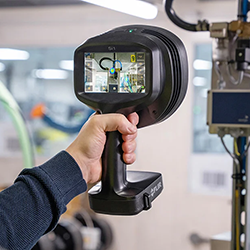2022 Manufacturing Predictions from iBASEt
.jpg)
Prediction #1: Manufacturers will Ramp up Digital Initiatives as Remote Working Becomes the Norm
While some discrete manufacturers initially regarded remote working as a short-term reaction to the pandemic, this year it will become a more permanent shift. Having found a way to make distributed workforce structures succeed, and with it being impossible to ignore the risk of further social distancing measures being reintroduced at short notice. An increasing number of manufacturers will invest in new solutions to work this way in 2022.
Ensuring that the right personnel are onsite to perform specific tasks has proven to be very difficult over the last year and a half. For example, government-imposed travel restrictions due to the pandemic have highlighted the complications of failing to get the right personnel onsite when required, potentially impacting cost and performance outcomes from initial setup through to ongoing operations. As a result, many companies began to monitor their assets remotely while maintaining a certain level of staffing on the ground for support.
Remote-first operations empowers manufacturers to utilize a localized, less skilled workforce that can perform a wider scope of tasks under the remote guidance of trained professionals, helping to address the acute labor shortage facing manufacturers, among many other organizations. Running remote first-designed operations can significantly reduce safety hazards for operational workforces in many different heavy industries.
Prediction #2: Cloud Adoption will Unlock Expanded Access to Analytics – Driving a Revolution in Smarter Decision Support by Manufacturers
2022 will be the year discrete manufacturers start to unleash the full power of analytics. To date, some have been using analytics for quality inspection and security use cases, but it will increasingly be used across key areas of operations, such as overall production performance, customer experience, product traceability, and safety programs.
Recent research has validated that almost a quarter of discrete manufacturers have gone ‘all in’ on the cloud, migrating key operations and analytics applications to take full advantage of the benefits of a hosted cloud infrastructure. For the analytics revolution to truly take off, however, more will need to jump to the cloud.
Prediction #3: The Pursuit of Becoming a “Digital-First” Enterprise will Drive Further Cloud Adoption
Cloud in all its permutations will continue to play an ever greater, and even more dominant role as manufacturers pivot to a digital-first economy. Digital enablement is now a permanent, yet dynamic fixture in our world, particularly the manufacturing industry where it is helping to drive Industry 4.0 transformation in many ways. This transformation can offload data center costs, ease systems integration, and provide a cost-effective approach to scaling resources and infrastructure requirements. When some or all a company’s workforce is working remotely, supporting customers working from anywhere, the importance of your software being hosted locally in a corporate datacenter matters less.
The desire to become a “digital-first” enterprise is increasingly sought after by smaller manufacturers that previously might not have considered robust operations management systems as part of an Industry 4.0 strategy. New cost saving breakthroughs are occurring that has lowered the entry cost of such programs, helping to accelerate adoption.
Comments (0)
This post does not have any comments. Be the first to leave a comment below.
Featured Product

